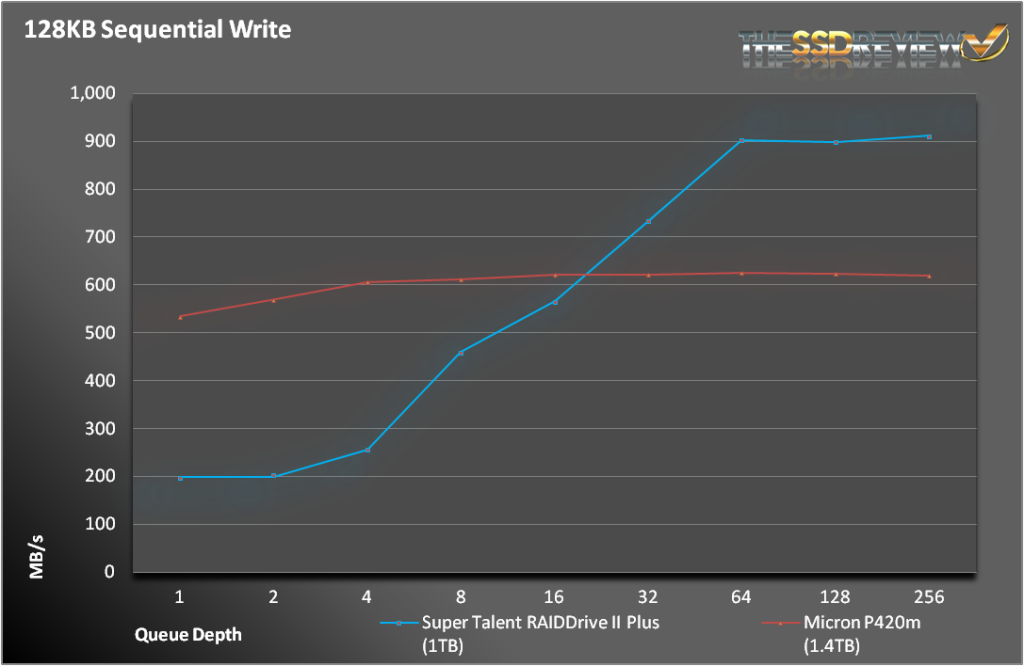MEASURING PERFORMANCE
As with all of our tests, the following tests were performed after a secure erase of the drive. The drive was also conditioned with a predefined workload until it reached steady state. We also test across the entire span of the drive.
Sequential operations proved more to the liking of the RAIDDrive II Plus. At low write queue depths, it could not keep up with the Microm P420m, but for high queue depths, it pulled away. The exact opposite is true for read operations. While read operations matched the specifications, the write performance was nowhere close the claimed 3.2GB/s. If we make changes to our tests, including increasing the block size and reducing the total amount of data written, we can get much closer to that number. With 1GB of cache, it can be hard to tell whether you a measuring NAND speed or cache speed, which is why we run our tests for extended periods of time.
For the sequential results, we compared the RAIDDrive II Plus against the Micron P420m. In the random 4KB tests, we had to remove the P420m because the results skewed the scale so much that the RAIDDrive II Plus’ results disappeared. As we saw with our latency tests, the RAIDDrive II Plus is outclassed by a single SSD.
SNIA IOPS TESTING
The Storage Networking Industry Association has an entire industry accepted performance test specification for solid state storage devices. Some of the tests are complicated to perform, but they allow us to look at some important performance metrics in a standard, objective way.
SNIA’s Performance Test Specification (PTS) includes IOPS testing, but it is much more comprehensive than just running 4KB writes with IOMeter. SNIA testing is more like a marathon than a sprint. In total, there are 25 rounds of tests, each lasting 56 minutes. Each round consists of 8 different block sizes (512 bytes through 1MB) and 7 different access patterns (100% reads to 100% writes). After 25 rounds are finished (just a bit longer than 23 hours), we record the average performance of 4 rounds after we enter steady state.
- Preconditioning: 3x capacity fill with 128K sequential writes
- Each round is composed of .5K, 4K, 8K, 16K, 32K, 64K, 128K, and 1MB accesses
- Each access size is run at 100%, 95%, 65%, 50%, 35%, 5%, and 0% Read/Write Mixes, each for one minute.
- The test is composed of 25 rounds (one round takes 56 minutes, 25 rounds = 1,400 minutes)
The SNIA testing shows the same general theme that we have already observed. The RAIDDrive II Plus just isn’t up for the task when it comes to small block, random performance. Though there aren’t any weird behaviors, once again most single enterprise SSDs would outperform it.
 The SSD Review The Worlds Dedicated SSD Education and Review Resource |
The SSD Review The Worlds Dedicated SSD Education and Review Resource | 


Any warranty mentioned? My big concern is the heavy use of those mini daughter card connectors. They tend to be susceptible to thermal expansion/contraction which can cause failures/corruptions. Also, I couldn’t see any supercaps on this unit.
I don’t have warranty information, my apologies. I almost included information about the USB connectors lifespan because of possible fretting, but decided to leave it out because the boards are incredibly secure. In higher shock and vibration environments (greater than a server rack), it could be a concern.
It’s not the USB connectors I worried about but those tiny daughterboard connectors.I didn’t see any screws holding the memory/controller card pairs together.